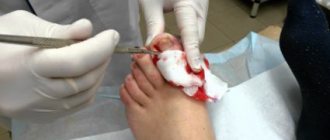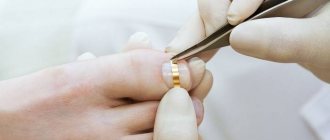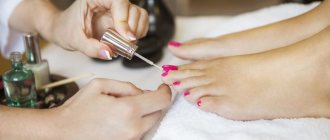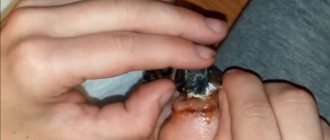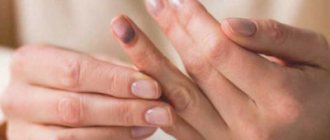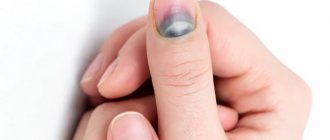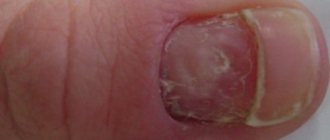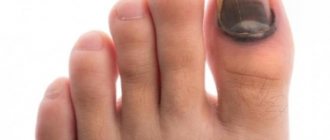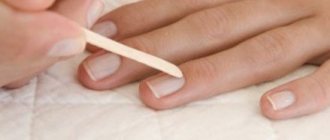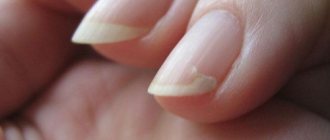How long does it take for a nail to grow after an injury?
After hitting the finger, the plate begins to peel off from the base. The nail comes off after an injury, usually within a few days. Then the process of growth of a new plate begins. It is influenced by the following factors:
- time of year (nails grow longer in winter);
- gender of the person (in women the plates grow faster);
- age (growth slows down over time);
- hormonal background.
How long the toenail takes off and how long it grows depends on the factors described above, as well as the degree of the bruise. On average, the healing process takes 2-3 weeks, and the regrowth period can reach 6 months. This conclusion is made from the fact that in four weeks the plate grows by approximately 3-4 mm. Damage to the growth plate during surgery to remove the plate after injury can increase the time it takes to grow back.
The nail on the big toe does not grow after a bruise
Toenails are designed to protect the terminal phalanges of the fingers, where the nerve endings are located. If they were not there, then a person would constantly experience unbearable pain when walking or receiving a slight blow. That's why it's so important to care for them properly. But it is during care that some people notice that the large toenail does not grow, has changed its shape and has become painful. Why is this happening?
Causes of nail peeling
The nail may peel off for the following reasons:
- the appearance of fungal infections;
- falling a heavy object onto your finger;
- injury during manicure;
- sloppy jump;
- injury;
- compression (when wearing tight shoes).
Whether a nail comes off after an injury depends on its severity. If the wrong tools were used during manicure, then the likelihood that the plate will fall off is low. However, if a nail falls off after a blow, then this is a completely natural pattern. For example, if a heavy object falls on your foot, your big toenail will likely peel off after a few days. The nail falls off in most cases even after strong squeezing.
Non-viability of toenails
If your toenail does not grow, then you should go to the doctor. The thing is that this can happen for two reasons. Either you have athlete's foot (fungal infection) or the nail has become nonviable and requires complete removal.
Surely, you have a question - how can a nail become unviable? To answer this question, it is necessary to delve into the structure of the nail, which we, naturally, will not do, since it will take too much time. Well, in short, we can say the following: the nail consists of dead particles that accumulate and form dense tissue, which we see on the toes or hands.
There are no nerve endings in this tissue, which is why we do not experience pain when cutting and filing our nails. When the process of accumulation of dead particles is disrupted, the nail stops growing. In this case, the growth of the cuticle “freezes”, and the nail plate itself thickens and shortens.
Solving this problem is very difficult. It is necessary to first establish the reason why the toenails do not grow and have become unviable, which cannot be done without a doctor, and eliminate it. After this, you need to remove the nail itself so that a healthy nail plate begins to grow in its place.
By the way, the growth of the nail plate can freeze as a result of its frequent injury. For example, when wearing tight, uncomfortable shoes, bumps or poor-quality manicure.
Mycosis
Mycosis is a fungal infection of the nails, which is accompanied by a number of characteristic symptoms:
- yellowing of the nail plate;
- deformation of the shape (the nail may become dense, convex, lumpy, etc.);
- the appearance of white spots or streaks on the nail;
- slower growth of the nail plate;
- its departure from the nail bed;
- the appearance of an unpleasant odor;
- delamination and brittleness of the nail.
However, it is not at all necessary that all these symptoms will be observed at the same time. Nail fungus is a disease that develops very slowly and can sometimes be accompanied only by itching or burning.
And if your big toenail does not grow, and you have at least one of the symptoms described above, then you should immediately seek help from a dermatologist. He will scrape the surface of the nail, which will allow you to determine the exact type of pathogen and select the appropriate treatment.
This requires the use of various medications, both in the form of creams and gels, and in the form of tablets. The thing is that the fungus does not affect the nail itself, but the nail bed. Through it, it penetrates deep into the soft tissues and general bloodstream, and then spreads throughout the body.
And if you treat the fungus only from the outside, then you will certainly achieve good results, but only for a certain time. Signs of a fungal infection may appear on other parts of the body. So you should not self-medicate.
What to do if your toenail does not grow?
If you have been to the doctor and no serious reasons have been identified for why your toenails do not grow, then maybe your body simply does not have enough vitamins and your nails are growing, but very slowly?
How a new plate grows after injury
If the nail has moved away from the skin due to the blow, then you need to act quickly. After receiving a bruise, you should relieve the pain by applying cold, for this you need to apply ice to your finger for 3-4 minutes, then repeat the steps again. This will help the hematoma resolve. Then you should treat the surface with hydrogen peroxide. After this, severe rejection of the plate will begin, which can be prevented by gluing an adhesive plaster or applying a pressure bandage. These actions can help: the plate will not be completely torn off and will be able to adhere to the skin. The cause of rejection is hemorrhage: the plate will rise and peel off.
If the nail is completely peeled off, a new plate begins to grow. But there are times when the nail tears and does not grow even after a month, this is due to the fact that the growth zone of the nail is damaged. In this situation, you need to contact a specialist for advice.
How a new nail grows after an injury depends on its nature. The deformation of the plate is caused by the inflammatory process, but then a smooth plate begins to grow.
Various types of injuries
If discomfort occurs in the area of only one plate, for example on the thumb or little finger, the most likely cause is a bruise. It is necessary to carefully examine the condition of the stratum corneum. If there is even a slight hemorrhage underneath, the cause is definitely trauma. Regarding why there is pain on the hands under the nails in this case. When an injury occurs that is not accompanied by a violation of the integrity of the skin and stratum corneum, the capillaries located directly under the plate or next to it rupture. The natural result is the outpouring of liquid connective tissue.
Most often, you will notice dots, spots or stripes of dark burgundy or black under the nail. As the bruise resolves, it begins to take on a bluish tint.
After suffering a serious injury, it is recommended to consult a doctor. Minor injuries do not require treatment and go away on their own within a few days.
Nail removal procedure after injury
If the plate itself does not come off, but is severely deformed, the doctor may suggest removing the nail after the injury. This will help reduce the risk of infection under the nail and the growth of an abnormally shaped plate. The operation is performed in several stages:
- Use of local anesthesia. It is necessary because the procedure is painful.
- The doctor inserts the instrument under the plate and separates it from the skin. If part of the plate is affected, only that part is removed.
- Applying antibiotic ointment to the wound.
- Dressing.
What are they doing in the hospital
You need to tell the doctor how and when the injury occurred, what first aid was provided. Doctors will examine the injury, give you an x-ray and a tetanus shot if more than ten years have passed since your last immunization. The doctor will ask about the presence of concomitant diseases, measure blood pressure, and check blood tests.
If there is a need for surgery, pain relief is first performed. Prick a finger or an area in the subungual bed with a solution of novocaine. The victim will feel numb and will not experience pain during manipulation. If surgery involves bleeding, a tourniquet is applied to the finger. This allows you to reduce blood loss and clearly see the wound. Antibiotics are not prescribed if the wound is sterile and was well treated in emergency care.
To remove blood from under the plate, the doctor makes a hole in the nail. The procedure is painless, the blood is drained, and the throbbing pain subsides. If the doctor suspects that the nail bed is damaged, he removes the plate. This is usually required in cases where the hematoma is extensive and there is bone damage.
A cut
If there is a lacerated wound to the plate, then the nail must be partially removed, and the soft tissue must be sutured. After the procedure, the tissues are placed in place, secured with medical glue. Instead of a plate, the doctor may install medical gauze material, which is removed after a few weeks as the new nail grows.
Amputation
It is not always possible to replace the amputated part of the finger. The tissue may not take root, and the operation itself requires high technology.
Detachment
It is not dangerous if the bed is not involved in the process. But when a nail is torn off, damage to the nail bed often occurs, which must be repaired.
Fracture
In case of a fracture, immobilization is required with a plaster splint. If the fracture is open or a metal pin is installed, antibiotics are prescribed to prevent infection.
What pharmaceutical and folk remedies can mitigate the consequences?
When the nail has already peeled off after a blow, you need to soothe the skin and relieve inflammation, this can be done using the following folk recipes:
- Salt bath. Dissolve 200 sea salt in 2 liters of water and dip your finger into the mixture. The bath should be done twice a day, it will soothe the skin.
- Compress based on chamomile infusion. Apply it to the plate twice a day for half an hour.
- You should take yarrow and plantain leaves in equal proportions, pour 50 ml of boiling water over them, and let them brew for 2-3 hours. Dip a cotton pad in this mixture and apply it to the bruise.
- You should mix 100 grams of soda, 100 grams of salt, pour 2 liters of warm water over them and mix thoroughly. Dip your finger into the bath. After which you should rinse it with clean water.
- In a ratio of 1:3, you need to dilute a solution of dimexide with novocaine (0.25%), moisten a cotton pad in this solution and apply it to the plate for half an hour.
Analgesics (Acecardol, Ketanov, Diklak, Piroxicam) will help relieve pain. And to prevent the appearance of a hematoma - heparin ointment. It needs to be used 2 times a day.
Another effective ointment for treating toenails and fingernails after injury is Arnica. Its main properties are an anti-inflammatory effect, increased blood circulation in the area of injury, and relieving swelling.
Badyaga gives excellent results. You need to dilute the badyagi powder with water so that the consistency is similar to gruel, and apply it to the nail. Repeat the procedure once a day.
It is advisable to provide the maximum possible rest to the leg (arm), avoid overexertion, so it can recover on its own. A bruised nail takes a long time to heal, and pain can last for more than two weeks. If this period is exceeded, you should consult a doctor.
Above are methods on how to help a damaged nail peel off faster. Thus, it will take a long time to eliminate the consequences of the injury. Patience and proper promotion of rapid healing are important in this process.
Source of the article: https://nails-info.ru/bolezni-nogtej/zabolevaniya/kak-rastet-novyj-nogot-posle-travmy.html
Non-viability of toenails
If your toenail does not grow, then you should go to the doctor. The thing is that this can happen for two reasons. Either you have athlete's foot (fungal infection) or the nail has become nonviable and requires complete removal.
Surely, you have a question - how can a nail become unviable? To answer this question, it is necessary to delve into the structure of the nail, which we, naturally, will not do, since it will take too much time. Well, in short, we can say the following: the nail consists of dead particles that accumulate and form dense tissue, which we see on the toes or hands.
There are no nerve endings in this tissue, which is why we do not experience pain when cutting and filing our nails. When the process of accumulation of dead particles is disrupted, the nail stops growing. In this case, the growth of the cuticle “freezes”, and the nail plate itself thickens and shortens.
Solving this problem is very difficult. It is necessary to first establish the reason why the toenails do not grow and have become unviable, which cannot be done without a doctor, and eliminate it. After this, you need to remove the nail itself so that a healthy nail plate begins to grow in its place.
By the way, the growth of the nail plate can freeze as a result of its frequent injury. For example, when wearing tight, uncomfortable shoes, bumps or poor-quality manicure.
Mycosis
Mycosis is a fungal infection of the nails, which is accompanied by a number of characteristic symptoms:
- yellowing of the nail plate;
- deformation of the shape (the nail may become dense, convex, lumpy, etc.);
- the appearance of white spots or streaks on the nail;
- slower growth of the nail plate;
- its departure from the nail bed;
- the appearance of an unpleasant odor;
- delamination and brittleness of the nail.
However, it is not at all necessary that all these symptoms will be observed at the same time. Nail fungus is a disease that develops very slowly and can sometimes be accompanied only by itching or burning.
And if your big toenail does not grow, and you have at least one of the symptoms described above, then you should immediately seek help from a dermatologist. He will scrape the surface of the nail, which will allow you to determine the exact type of pathogen and select the appropriate treatment.
This requires the use of various medications, both in the form of creams and gels, and in the form of tablets. The thing is that the fungus does not affect the nail itself, but the nail bed. Through it, it penetrates deep into the soft tissues and general bloodstream, and then spreads throughout the body.
And if you treat the fungus only from the outside, then you will certainly achieve good results, but only for a certain time. Signs of a fungal infection may appear on other parts of the body. So you should not self-medicate.
What to do if your toenail does not grow?
If you have been to the doctor and no serious reasons have been identified for why your toenails do not grow, then maybe your body simply does not have enough vitamins and your nails are growing, but very slowly?
In this case, you should make various masks for nail growth at home, use medicated varnishes (there are a large selection of them in pharmacies), perform daily foot baths, etc. In addition, you need to take a course of multivitamins. But to do this, you need to consult with a specialist so that he can choose the most suitable complex for you.
And most importantly, do the right manicure. Don't touch your nail for a while. Give him time to recover. It may indeed be true that you previously damaged it with the same nail scissors when you cut it.
Only a doctor can tell you the exact reason why your toenails do not grow. After all, this phenomenon is quite rare and requires careful diagnosis. In any case, you should not self-medicate, since this is unlikely to lead to positive dynamics.
Source of the article: https://checkrx.ru/pochemy-ne-rastet-nogot-na-bolshom-palce-nogi-v-chem-prichina/
Mechanism of subungual hematoma formation
When a nail is bruised, nerves and small vessels are damaged, blood flows into the soft tissue, forming a hematoma. As a result of swelling, the nerve endings, of which there are many in this area, are compressed, which leads to very severe pain. The nail plate is quite dense, which creates areas of high pressure in the tissues, which increases pain.
The appearance of hematomas and bruises under the nails is caused by fractures, sprains, as well as diseases that affect the condition of blood vessels and weaken their walls (scurvy, diabetes).
Causes
Most injuries result from the following::
- hit on the nail . This could be being hit with a hammer, being pinned by a door or drawer, being in a car accident, or being bitten by animals or people. This type of injury usually results in blood appearing under the nail, called a subungual hematoma.
- cuts. Occurs under the influence of knives, scissors, and sharp files. The nail plate may be damaged or torn off, or a foreign object may become trapped under the plate.
- inappropriate shoes. Regular injuries to the toenails caused by improperly fitting shoes can lead to deformation of the plate. The deformities resemble a fungal infection: the plates become thickened or discolored and then pull away from the nail bed, causing cosmetic problems.
- habit of biting nails and cuticles . It is the main cause of acute paronychia - an infection in which bacteria get under the tissue on the side of the nail and cause swelling, irritation, and severe pain.
Types of bruise
Depending on the severity of the injury, the following degrees of injury are distinguished:
- light . The damage is minor, in some cases soft tissue is affected. Within 24 hours the problem disappears on its own;
- moderate severity . The nail plate is damaged, a hematoma occurs in the area of injury (the nail turns blue); if this happens, the plate may peel off in the future;
- heavy . The nail plate is damaged, causing severe swelling and hemorrhage. There may be a dislocation of the finger, as well as cracks and fractures of the bone, and the nail plate peels off.
Prevalence
Damage to the fingertips and nail bed occurs at all ages, with a peak incidence in patients aged 4–30 years. Depending on the mechanism of injury, there may be various types of damage. Most often they occur due to pinching, for example, by a door.
The nails protect the dorsal surface of the distal phalanges - the outer part of the fingertips. They help pick up small objects and have a cosmetic function, so it is important to know the signs of damage and be able to provide first aid.
Approximately 50% of nail bed injuries requiring surgical intervention involve distal phalangeal fractures. If you have a finger injury, you must undergo an x-ray. ICD-10 damage code: S60.
More information about the structure of nails:
Symptoms
As a result of the studies, the fact was revealed that immediately after mechanical damage to soft tissue in the area of the fingernail or toenail (without bone fracture), hyperthermia, redness, swelling and pain occur. Using infrared thermography, it was found that after 10 seconds the temperature of the bruised area increases by 1.0–1.5 °C.
The temperature of the nail plate above the hematoma after 5 minutes becomes higher than in the middle phalanx of the same finger by 3.0–3.5 °C. At this level it lasts up to three hours.
Characteristic signs of a bruise:
- the finger swells and the nail turns purple or cherry blue. The size and shape of the cyanotic zone depends on the location and force of the impact;
- the process of hematoma formation is accompanied by pain. As a result of the formation of a high pressure zone, the pain becomes very intense, bursting, tugging.
After 1–2 days, the pain decreases, the temperature returns to normal, and the nail becomes blue or blue-black. If the injury is closed, then in most cases the purulent process does not join, but the swelling can spread to the entire finger.
The damaged nail grows, and at the same time the dark spot under the nail plate gradually moves. After some time, the color changes to blue, then to black. A damaged nail plate is completely replaced in 1–3 months.
If you fall on a straightened finger or hit the end part, a subcutaneous rupture of the flexor tendons may occur:
The nail phalanx is completely bent, with no extension movements
Flexion movements are preserved, but full flexion of the finger is impossible
Types of injuries and symptoms
There are several types of injuries. They can be isolated - when there is only one type of damage. If two or more types are simultaneously observed on one finger, then such an injury is called combined.
The following types of damage may occur:
- a subungual hematoma appears due to the accumulation of blood under the plate . The mechanism of damage is a direct blow to the nail. The platinum itself remains intact, but the vessels under the nail are injured. The accumulation of blood is red at first, then turns black. After two weeks, the hematoma turns blue. Characterized by severe pain of a pulsating nature;
- a laceration is a cut in the platinum, cuticle, bed . Occurs when injured by a cutting object, for example, a knife, scissors. Due to damage to the integrity of the integument, blood flows out;
- traumatic amputation - the nail is partially or completely torn off . Depending on the depth of the injury, crushed soft tissue and bone may be visible. Occurs when a finger gets caught in moving mechanisms or when a large load falls;
- nail detachment is the separation of the plate from the bed . Most often it appears as a result of injury or fungal infection. Part of the nail rises above the cuticle, and with the traumatic genesis of the pathology, bleeding is characteristic;
- the fracture of the distal phalanx can be closed, i.e. invisible to the eye . It can occur when falling or hitting the phalanx with a heavy object. Even if there is no deformation of the finger, an x-ray should be taken.
What to do if you bruise your fingernail
First aid
If there is a ring on your finger, you need to remove it first, since in the future it will not be possible to do this due to increasing swelling. In order to avoid the formation of a hematoma, place the finger under a stream of cold water and apply a cold compress or ice to it. This will help narrow the blood vessels and reduce pain. The cold is applied for 10 minutes, then take a break.
If abrasions or cuts are detected, they are treated with antiseptics (Hydrogen Peroxide, Chlorhexidine, Zelenka or Iodine). If the nail is partially detached, the wound is washed, and in order to prevent further trauma, a bandage with anesthetic ointment is applied.
For these purposes, use a bandage, gauze or a piece of fabric. You should not glue the damaged nail with an adhesive plaster, as it will be difficult to remove it in the future. The procedure will be very painful, and if the nail plate has peeled off, it can be completely torn off.
Urgent Care
If you or a client have a finger injury in the salon, you need to provide emergency medical care.
First aid instructions for a nail injury:
- The person needs to be seated or laid down to prevent fainting. The injured arm or leg should be placed in an elevated position. This will help reduce blood loss.
- Remove jewelry from the injured limb.
- If there is bleeding, apply a sterile bandage or gauze. When the blood stops coming out, remove the bandage and inspect the injury.
- For pain relief, an injured person should take NSAIDs (Analgin, Ibuprofen), if there is no allergy to the drug. Analgin at a dosage of 500 mg begins to act 5 minutes after administration, the maximum effect is achieved after 30 minutes. Ibuprofen 200 mg begins to act in 10 minutes, the maximum effect is in an hour. Contraindications for use are peptic ulcers of the gastrointestinal tract and aspirin-induced asthma.
- Wash the wound with running water and soap and apply a sterile bandage.
- Apply ice or a cold object for no longer than 30 minutes. Cold reduces swelling, pain and blood loss.
- It is not recommended to try to remove the nail, pull the plate or try to achieve a physiological position.
- If amputation has occurred, the torn parts must be wrapped in sterile cloth and placed in a clean bag. Place this bag in another ice pack to take with you to the hospital.
The technician in the salon should have a first aid kit, including sterile materials, so that emergency assistance can be provided at any time. In case of a nail injury, you will need a sterile bandage or gauze. For shallow cuts without severe bleeding, it is enough to use a medical bactericidal plaster.
We invite you to watch a video from the Peoples' Friendship University of Russia, Department of Disaster Medicine, RUDN University, on providing first aid for a finger injury with suspected fracture.
Recovery period
During the entire rehabilitation period, it is necessary to avoid physical exertion on the injured arm.
The period of disability after injury ranges from 1 to 3 weeks. With subcutaneous tendon rupture, fractures and bone cracks, it increases to one month.
In cases where after this period the injured finger does not straighten, surgical intervention may be required.
If within a week after the injury the patient’s condition does not improve, the pain intensifies or purulent discharge appears, it is necessary to seek repeated consultation with a traumatologist or surgeon to exclude the development of complications.
When you need to go to hospital urgently
You need to call an ambulance or take the injured person to the emergency room if:
- The tip of a finger or toe is partially or completely amputated.
- Heavy bleeding does not stop for ten minutes or longer.
- The finger is deformed, which may indicate a fracture or dislocation. If you can't bend or straighten your finger as usual, the tendons may be damaged.
- There is a deep or long wound that will require stitches.
- A subungual hematoma occupies more than a quarter of the nail area or there is severe pain.
- The nail plate is partially or completely separated from the bed.
- The injury is caused by a bite from an animal or person.
- A routine tetanus vaccination was missed.
- In the presence of concomitant diseases, such as diabetes mellitus, blood clotting pathologies, oncological conditions and chemotherapy.
If the damaged nail is injured by surrounding tissues, then if you have sterile scissors, you can carefully cut off the sharp edge yourself.
Symptoms and first aid
A nail injury will be characterized by the following symptoms:
- The formation of a bruise, as a result of which the nail becomes bluish or even black. This is explained by the darkening of the nail plate due to a hematoma on the skin.
- Over the course of two days, the nail turns yellow, which signals the process of cell death.
Until the bruising goes away, the pain still remains: at first it is constant and aching, and then sharp, occurring when hard objects come into contact with the plate. The finger swells and the skin takes on a reddish tint.
As a rule, injuries of this kind can be accompanied. In case of a finger injury, it is initially necessary to establish the presence or absence of a violation of the integrity of the bone, during which the soft tissues swell and severe pain occurs when moving.
Damage to fingernails is accompanied by irritation of various nerve endings and, as a rule, severe pain, so you should try to immediately neutralize such discomfort. To achieve this, the following measures are being taken:
- You need to apply a cold object to the damaged area: snow, ice or metal.
- The nail plate must be disinfected with hydrogen peroxide or iodine.
- Seek medical help.
If the hematoma is large enough, the skin and nail around it become black.
There is a possibility that the nail plate will be rejected. This can be prevented in the following way: the finger must be treated with iodine, wrapped in an adhesive plaster, and go to a medical center. The doctor will be able to make a small hole in the nail to allow the blood to drain out. This procedure should not be done on your own, as there is a high risk of blood poisoning and subsequent rejection of the nail.
As first aid to prevent blue nails from appearing, you should do the following.
- After the bruise itself has occurred, you need to raise the limb whose nail the trouble occurred to a certain height. This will prevent new blood from flowing to the damaged area.
- If the pain is severe, you need to take a pain reliever, such as paracetamol. By taking such measures, you can easily prevent the enlargement of the hematoma and the blueness of the nail plate.
There are a number of treatment procedures that also help in the fight against a bruised nail. Treatment must be carried out necessarily, as an accumulation of pus may appear on the skin. If such measures are not taken, there is a possibility that the process of nail rejection will begin and a new, uneven one will grow in its place, which is not aesthetically pleasing. During recovery, you need to provide rest for the injured finger. Thanks to such conditions, the hematoma will disappear faster, and the nail will look better and healthier
After damage in the form of a bruise, it is impossible to treat the nail even without the use of medications. Often, for such injuries, doctors may prescribe the following medications:
- Medicines that relieve pain. These could be aspirin or analgin tablets. Compresses with water and dimexide are also used.
- Homeopathic remedies. Among them, the most popular is Arnica ointment. It has an anti-inflammatory effect, eliminates swelling and activates blood circulation.
- Heparin ointment, which is used as a means to reduce the intensity of pain. It also removes the hematoma and activates the recovery process.
The course of taking medications and using medications is determined by the doctor strictly individually and depending on the injury. If you choose a drug yourself, it should be used throughout the entire period of nail restoration. Complex effects will help make treatment more effective.


